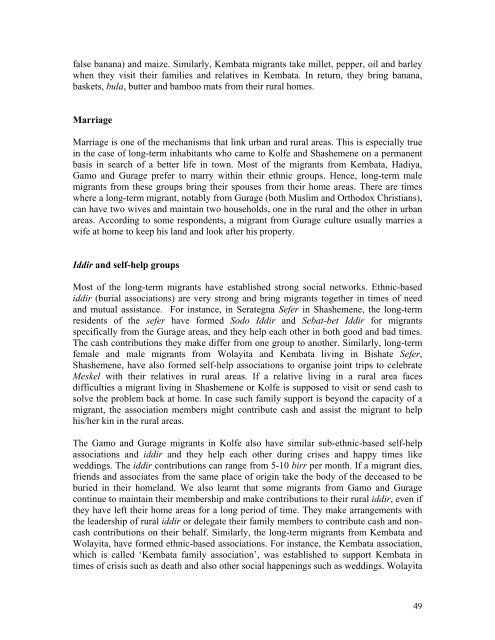Migration and Rural-Urban Linkages in Ethiopia
Migration and Rural-Urban Linkages in Ethiopia - Ethiopian Review
Migration and Rural-Urban Linkages in Ethiopia - Ethiopian Review
You also want an ePaper? Increase the reach of your titles
YUMPU automatically turns print PDFs into web optimized ePapers that Google loves.
false banana) <strong>and</strong> maize. Similarly, Kembata migrants take millet, pepper, oil <strong>and</strong> barleywhen they visit their families <strong>and</strong> relatives <strong>in</strong> Kembata. In return, they br<strong>in</strong>g banana,baskets, bula, butter <strong>and</strong> bamboo mats from their rural homes.MarriageMarriage is one of the mechanisms that l<strong>in</strong>k urban <strong>and</strong> rural areas. This is especially true<strong>in</strong> the case of long-term <strong>in</strong>habitants who came to Kolfe <strong>and</strong> Shashemene on a permanentbasis <strong>in</strong> search of a better life <strong>in</strong> town. Most of the migrants from Kembata, Hadiya,Gamo <strong>and</strong> Gurage prefer to marry with<strong>in</strong> their ethnic groups. Hence, long-term malemigrants from these groups br<strong>in</strong>g their spouses from their home areas. There are timeswhere a long-term migrant, notably from Gurage (both Muslim <strong>and</strong> Orthodox Christians),can have two wives <strong>and</strong> ma<strong>in</strong>ta<strong>in</strong> two households, one <strong>in</strong> the rural <strong>and</strong> the other <strong>in</strong> urbanareas. Accord<strong>in</strong>g to some respondents, a migrant from Gurage culture usually marries awife at home to keep his l<strong>and</strong> <strong>and</strong> look after his property.Iddir <strong>and</strong> self-help groupsMost of the long-term migrants have established strong social networks. Ethnic-basediddir (burial associations) are very strong <strong>and</strong> br<strong>in</strong>g migrants together <strong>in</strong> times of need<strong>and</strong> mutual assistance. For <strong>in</strong>stance, <strong>in</strong> Serategna Sefer <strong>in</strong> Shashemene, the long-termresidents of the sefer have formed Sodo Iddir <strong>and</strong> Sebat-bet Iddir for migrantsspecifically from the Gurage areas, <strong>and</strong> they help each other <strong>in</strong> both good <strong>and</strong> bad times.The cash contributions they make differ from one group to another. Similarly, long-termfemale <strong>and</strong> male migrants from Wolayita <strong>and</strong> Kembata liv<strong>in</strong>g <strong>in</strong> Bishate Sefer,Shashemene, have also formed self-help associations to organise jo<strong>in</strong>t trips to celebrateMeskel with their relatives <strong>in</strong> rural areas. If a relative liv<strong>in</strong>g <strong>in</strong> a rural area facesdifficulties a migrant liv<strong>in</strong>g <strong>in</strong> Shashemene or Kolfe is supposed to visit or send cash tosolve the problem back at home. In case such family support is beyond the capacity of amigrant, the association members might contribute cash <strong>and</strong> assist the migrant to helphis/her k<strong>in</strong> <strong>in</strong> the rural areas.The Gamo <strong>and</strong> Gurage migrants <strong>in</strong> Kolfe also have similar sub-ethnic-based self-helpassociations <strong>and</strong> iddir <strong>and</strong> they help each other dur<strong>in</strong>g crises <strong>and</strong> happy times likewedd<strong>in</strong>gs. The iddir contributions can range from 5-10 birr per month. If a migrant dies,friends <strong>and</strong> associates from the same place of orig<strong>in</strong> take the body of the deceased to beburied <strong>in</strong> their homel<strong>and</strong>. We also learnt that some migrants from Gamo <strong>and</strong> Guragecont<strong>in</strong>ue to ma<strong>in</strong>ta<strong>in</strong> their membership <strong>and</strong> make contributions to their rural iddir, even ifthey have left their home areas for a long period of time. They make arrangements withthe leadership of rural iddir or delegate their family members to contribute cash <strong>and</strong> noncashcontributions on their behalf. Similarly, the long-term migrants from Kembata <strong>and</strong>Wolayita, have formed ethnic-based associations. For <strong>in</strong>stance, the Kembata association,which is called ‘Kembata family association’, was established to support Kembata <strong>in</strong>times of crisis such as death <strong>and</strong> also other social happen<strong>in</strong>gs such as wedd<strong>in</strong>gs. Wolayita49




![to read the full report [pdf, Amharic] - Ethiopian Review](https://img.yumpu.com/52737829/1/190x245/to-read-the-full-report-pdf-amharic-ethiopian-review.jpg?quality=85)











